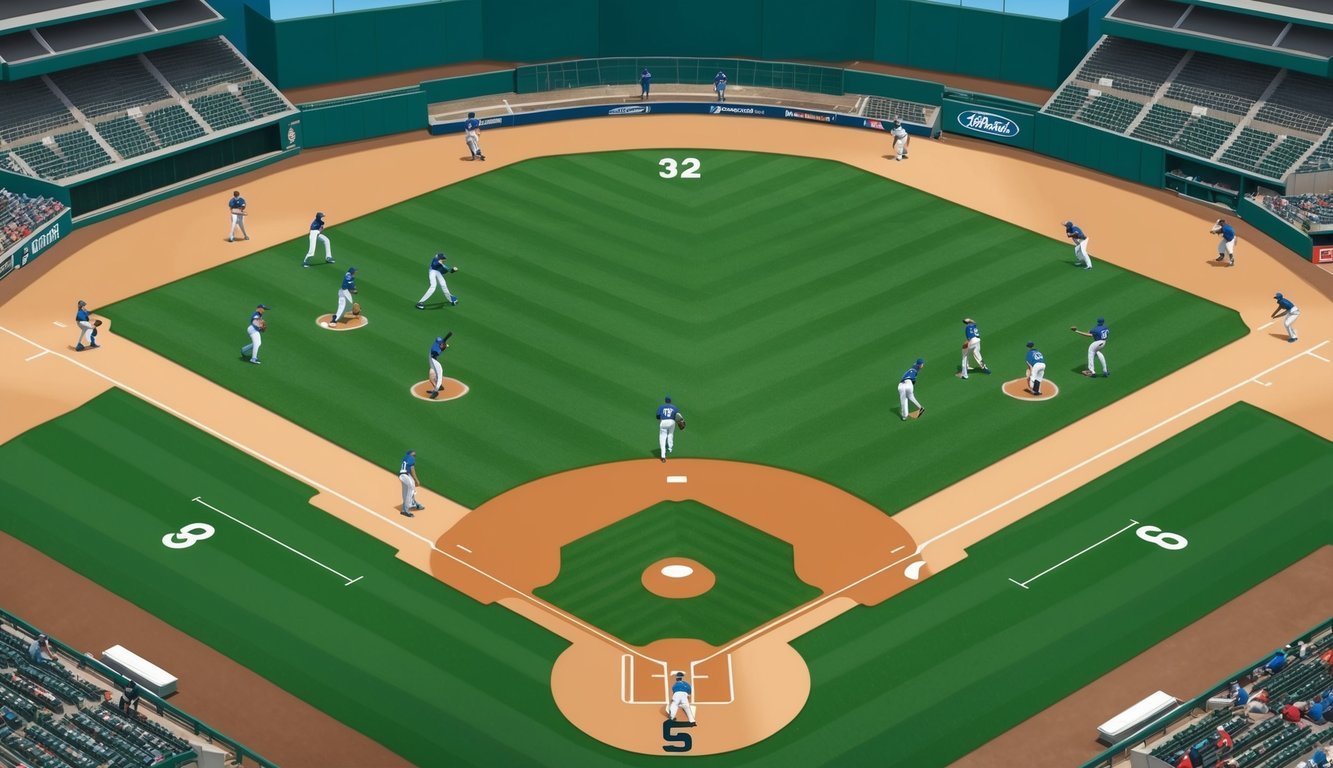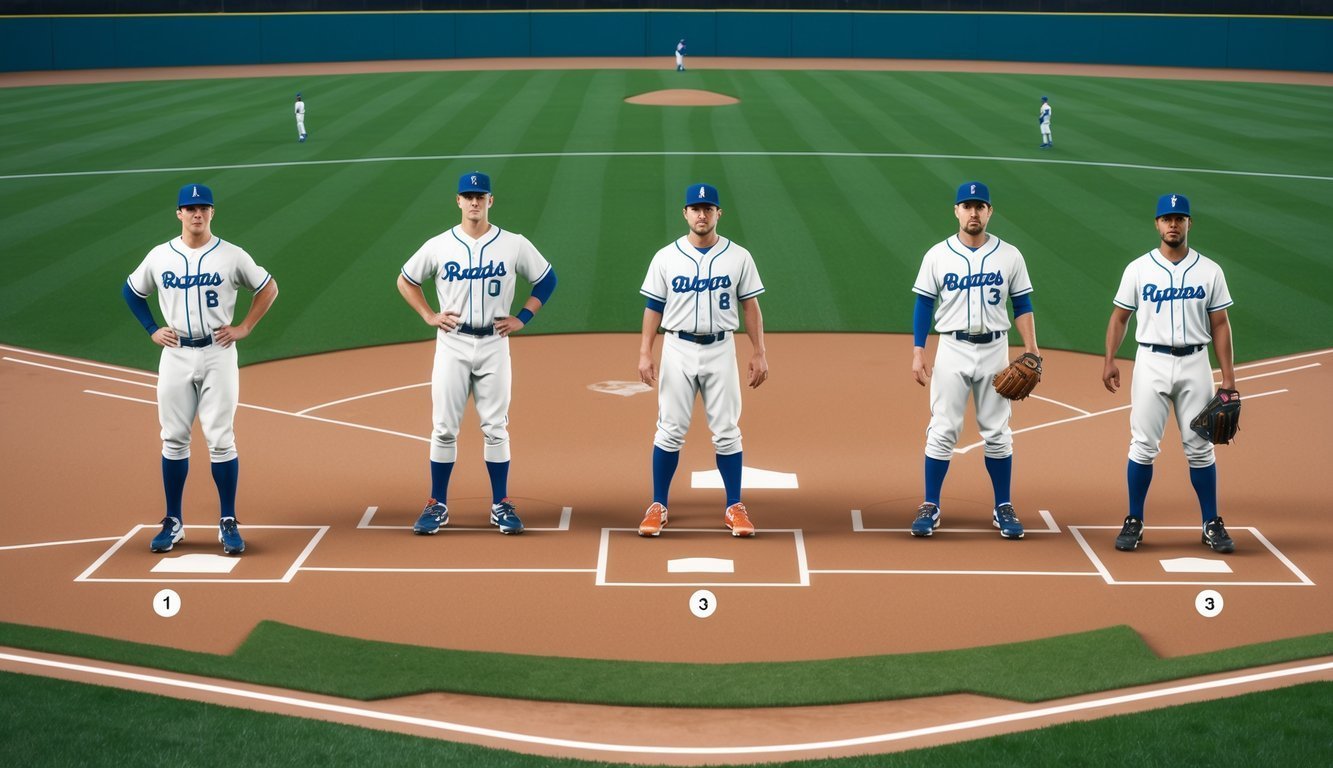Baseball is a game of numbers, and not just on the scoreboard.
Each position on the field has a unique number assigned to it, creating a shorthand that players, coaches, and fans use to communicate quickly and efficiently. These numbers, ranging from 1 to 9, represent the nine defensive positions on a baseball diamond and are essential for scoring, strategizing, and understanding the game.
The numbering system starts with the pitcher as number 1 and moves counterclockwise around the infield, ending with the right fielder as number 9.
This simple yet effective method allows for easy identification of plays and positions, such as the famous “6-4-3 double play” involving the shortstop, second baseman, and first baseman.
It’s a language all its own, spoken fluently by those who love America’s pastime.
Understanding these position numbers opens up a whole new level of appreciation for baseball.
It allows fans to follow the action more closely, helps players communicate on the field, and gives coaches a shorthand for discussing defensive alignments.
Whether you’re a seasoned fan or new to the sport, knowing these numbers is key to fully enjoying the intricate dance of offense and defense that makes baseball so captivating.
The Pitching Positions

Pitchers are the backbone of a baseball team’s defense, wearing the number 1 on their jerseys.
These players have the crucial task of throwing the ball to the batter from the pitcher’s mound, aiming to get outs and prevent runs.
The Ace: Starting Pitcher
The ace is the team’s top starting pitcher, often taking the mound for important games.
This pitcher typically has the best combination of pitches, control, and stamina.
Aces aim to pitch deep into games, ideally completing 6-9 innings.
Starting pitchers work on a rotation, usually pitching every 4-5 days.
They need a variety of pitches to keep batters guessing, including fastballs, curveballs, and changeups.
A strong ace can rack up strikeouts and dominate opposing lineups.
During games, starters stand on the rubber, a white plate on the pitcher’s mound.
From here, they launch their arsenal of pitches, trying to outsmart and overpower batters.
The Bullpen: Relief and Closer Pitchers
Relief pitchers come in when the starter tires or struggles.
They’re divided into several roles based on when they typically enter the game.
Long relievers pitch multiple innings, often in less competitive situations.
Middle relievers handle the 6th and 7th innings of close games.
Setup men pitch the 8th inning, bridging to the closer.
Closers are responsible for securing the final outs in the 9th inning, often in high-pressure situations.
The use of each reliever depends on strategy, the score, and how many innings in baseball remain to be played.
Managers carefully decide when to use each type of reliever to maximize effectiveness and maintain a team’s chance of winning.
Closers, the relief aces, usually pitch the 9th inning with a lead.
They often throw hard and rely on 1-2 dominant pitches to get quick outs and secure wins.
Relief pitchers need to warm up quickly and perform under pressure.
They may enter with runners on base or in tight spots, making mental toughness crucial.
The Battery: Catcher and Pitcher Dynamics
The battery, consisting of the pitcher and catcher, forms the core of a baseball team’s defense.
These two players work in tandem to control the game’s pace and strategy from pitch to pitch.
Catching Behind Home Plate
The catcher crouches behind home plate, equipped with protective gear.
This position requires quick reflexes and strong defensive skills.
Catchers must be adept at receiving pitches, framing borderline strikes, and blocking wild throws in the dirt.
Skilled catchers excel at scooping low pitches and presenting them as strikes to umpires.
They also play a crucial role in controlling the running game by throwing out potential base stealers.
Catchers often act as field generals, calling pitches and positioning infielders.
Their unique vantage point allows them to see the entire field and direct defensive alignments.
Pitcher-Catcher Coordination
Effective batteries rely on seamless communication between pitcher and catcher.
They use a system of hand signals to select pitches and locations without tipping off opposing batters.
Catchers must understand each pitcher’s strengths, weaknesses, and preferred pitch sequences.
This knowledge helps them call a game that maximizes the pitcher’s effectiveness against different hitters.
The duo works together to keep batters off-balance by mixing pitch types, speeds, and locations.
A well-coordinated battery can exploit a batter’s weaknesses and induce poor contact or swings and misses.
Trust between pitcher and catcher is essential.
When in sync, they can execute complex strategies and adapt quickly to changing game situations.
Infield Defense Strategy

Infield defense forms the backbone of a team’s defensive strategy.
Proper positioning and coordination among infielders can make or break crucial plays during a game.
Corner Infielders: First and Third Base
First and third basemen guard the corners of the infield.
The first baseman covers a wide area, fielding ground balls and catching throws from other infielders.
They must have quick reflexes and good footwork to scoop low throws.
Third basemen need strong throwing arms to make the long throw across the diamond.
They often field hard-hit balls, requiring sharp reactions and solid glove work.
Both positions demand agility to handle bunts and slow rollers.
Corner infielders play a key role in defensive shifts, adjusting their positions based on the batter’s tendencies.
They also need to communicate effectively with middle infielders during double play situations.
Middle Infielders: Second Base and Shortstop
Second basemen and shortstops are the dynamic duo of the infield.
They’re responsible for covering a large area of the field and turning double plays.
The 6-4-3 double play (shortstop to second to first) is a classic example of their teamwork.
Shortstops typically have the strongest arms in the infield, allowing them to make deep throws from the hole.
They often take charge on pop-ups in the infield, calling off other players.
Second basemen need quick hands for swift transfers on double plays.
They also cover first base on bunts to the right side of the infield.
Both positions require excellent range, soft hands for fielding, and the ability to make quick decisions.
Middle infielders must constantly communicate and adjust their positioning based on the game situation and batter tendencies.
The Outfielders and Defensive Range

Outfielders play a crucial role in baseball’s defensive strategy.
They cover vast areas of the field, catch fly balls, and prevent extra-base hits.
Patrolling the Outfield: Left, Center, and Right
Left fielders (position #7) guard the area behind third base.
They need quick reactions to handle line drives and a strong arm to throw out runners.
Center fielders (position #8) cover the most ground.
They’re often the fastest players on the team, chasing down fly balls in both left-center and right-center gaps.
Right fielders (position #9) defend the area behind first base.
They typically have the strongest arms among outfielders to make long throws to third base or home plate.
Each outfielder must communicate effectively to avoid collisions when pursuing fly balls.
They also back up infield throws to prevent overthrows.
Handling Fly Balls and Field Positioning
Outfielders adjust their positions based on the batter, game situation, and field conditions.
They may play deeper to prevent extra-base hits or move in for a better chance at throwing out runners.
For fly balls, outfielders use the “drop step” technique.
This involves quickly moving back while keeping their eyes on the ball.
They often use their non-glove hand to shield their eyes from the sun.
Outfielders must also judge the trajectory of batted balls.
This skill helps them catch line drives and prevent home runs by leaping at the fence.
When retrieving grounders, outfielders use the “do-or-die” play.
They charge the ball aggressively to make a quick throw and prevent runners from taking extra bases.
Baseball’s Specialized Positions
Baseball teams utilize specialized roles to maximize offensive and defensive strategies.
These positions allow for tactical flexibility and give managers more options during games.
Designated Hitter and Pinch Players
The designated hitter (DH) is unique to the American League.
This player bats in place of the pitcher but doesn’t field.
DHs are often power hitters who can consistently produce runs.
Pinch hitters substitute for batters, usually in crucial situations.
They may have specific strengths, like hitting against left-handed pitchers or excelling with runners in scoring position.
Pinch runners replace baserunners, typically for speed.
They aim to steal bases or score from second on singles.
This role is crucial in close games where every run matters.
Role of Utility Players and Substitutions
Utility players are versatile athletes who can competently play multiple positions.
They provide flexibility for managers, allowing for strategic substitutions or covering injuries.
These athletes often excel at both infield and outfield positions.
Their adaptability makes them valuable assets, especially during double-switches or extra-inning games.
Substitutions in baseball can dramatically change game dynamics.
Managers might swap players for defensive improvements in late innings.
They also might make substitutions to gain platoon advantages against specific pitchers.
Effective use of specialized positions and substitutions can be the difference between winning and losing close games.
It’s a chess match that adds depth to baseball strategy.
